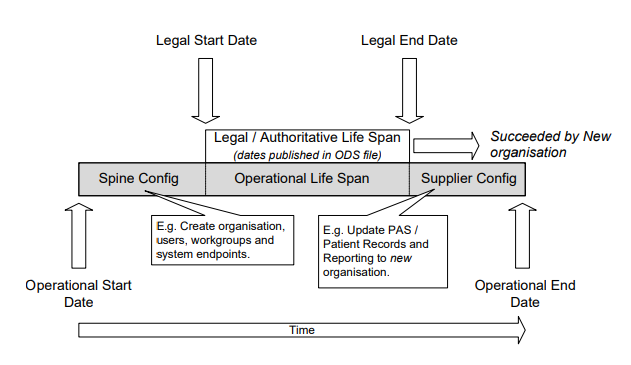A range of dates are supplied within ODS data, within a number of different contexts:
- the lifespan of an Organisation record
- the lifespan of an Organisation Site record
- Relationship: the duration of an association between two records
- Role: the dates during which a Role is allocated to a record
- Succession: the date upon which one record succeeded or was preceded by another
Dates can be derived from the genuine legal dates of establishment or dissolution of an entity, or knowledge of the legal commencement of new working associations and responsibilities. However this information is not always available and dates may instead simply reflect when the relevant artefacts were introduced to the data, or when the requirement for them was first identified.
Data Items
Data items include Start and End Dates and information on whether the dates are authoritative (Legal) or supplied to support operational system requirements (Operational).
Start and End Dates
Date elements always include a Start Date. A corresponding item for End Date exists but is not always used (i.e. for entities that have not yet closed, or for succession).
Dates are supplied in the format yyyy-mm-dd.
Type - Legal vs Operational
The current options of Date Type are: ‘Legal’, and ‘Operational’.
- Legal dates are authoritative and often defined by legislation.
- Operational dates exist in parallel and reflect the operational need of systems and services.
Often both sets of dates are the same however they can sometimes diverge; for example an Organisation’s record may need to remain open for a period of time following closure of the establishment in the real world. Maintaining an Operational view using dates allows for data to be migrated within a system, Spine connected
systems to be reconfigured and for users to be transferred.
The model provides data items that identify the type of a date, thus allowing both Legal and Operational dates to be included where applicable, and the end user to select the value required.
Wherever possible, the date on which an Organisation entity became legally established or was legally closed will be used as its Legal Start and End Dates, respectively – however this is not guaranteed: where a true legal date is not known or defined, a suitable date close to the time of the record’s creation will be chosen.
In the ORD API (only), Operational dates will be included by default, Legal dates will only be supplied where they differ from the Operational values; i.e. where the two values are the same, the Legal dates are simply omitted.
Operational Start Dates cannot fall in the future; they must be equal to or earlier than the date of their publication.
Conversely, Legal Start Dates can fall in the future; they may be later than the date of their publication. Both operational and legal End Dates can be later than their date of publication.
For the Organisation Element legal dates must be nested within operational dates, i.e.:
- Operational Start Dates must be equal to or earlier than Legal Start Dates
- Operational End Dates must be equal to or later than Legal End Dates
- Legal Start Dates must be equal to or later than Operational Start Dates
- Legal End Dates must be equal to or earlier than Operational End Dates
Note that the rules defined above apply to Start and End Dates of the Organisation Element ONLY and do not apply to Role or Relationship Elements.
Succession Dates
Dates provided for Succession are restricted in two aspects:
- Only Start Dates are used in Succession (succession links are never closed so End Dates are never applied).
- Only legal dates are applied to Succession.
